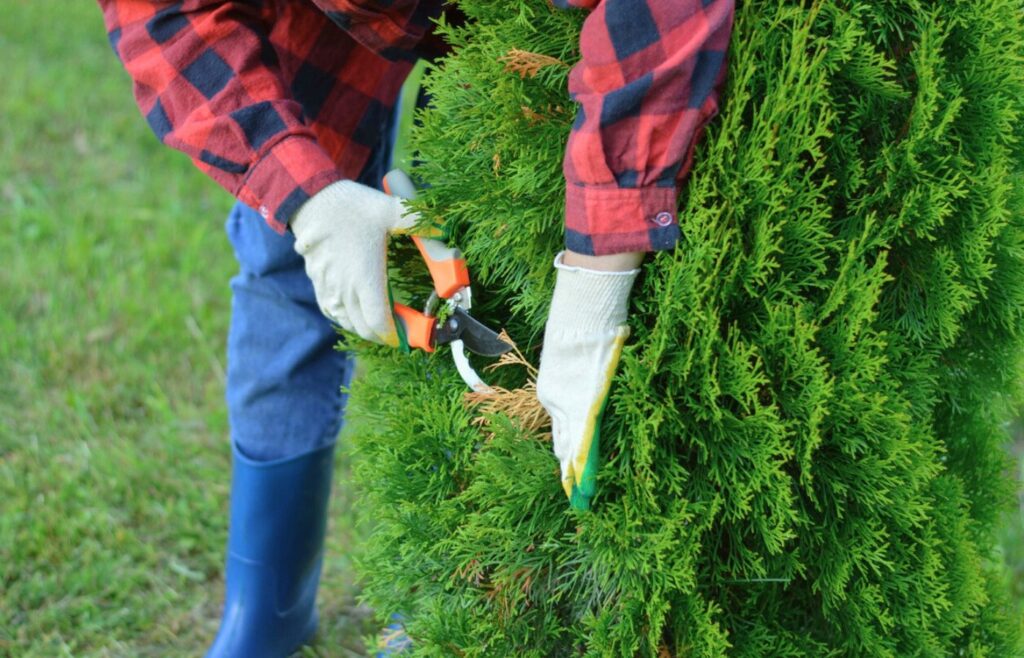Do you have a cypress hedge in your garden? Great choice! These robust shrubs beautifully decorate, protect, and structure your outdoor spaces. But do you know how to properly prune and care for them in the long run? Look no further; here are some practical tips to keep your hedge thriving!
Choosing the right tools for your cypress hedge
To effectively maintain your cypress hedge without hassle, using the right tools is essential. Do you know them all?
Essential basic tools
- Pruner: ideal for thin branches; choose sharp tools for clean cuts.
- Hedge shears: very handy for trimming thicker branches and refining the overall shape of the hedge.
- Electric or gas hedge trimmer: perfect if your hedge is large and requires significant intervention. Always remember to follow safety guidelines.
Additional tools based on your needs
- Pruning saw: great for removing dead or particularly thick branches.
- Pole pruner: ideal for safely reaching the highest branches without climbing.
- Rake: essential for efficiently cleaning up fallen leaves and branches after pruning.
Keep in mind that wearing durable gloves also protects your hands from injuries.
Essential preparations before pruning your hedge
Before using your tools, you must follow a few preparatory steps. Have you thought about inspecting your hedge?
Take the time to closely observe the condition of your hedge. Identify any diseased, damaged, or dead branches, as well as those growing in the wrong direction. These branches need to be removed to promote healthy growth.
Next, check your tools. They should be clean, sharp, and functional. This ensures clean cuts and prevents disease transmission from one plant to another.
How to trim your cypress hedge effectively?
There are two main techniques for trimming: what are the differences? Let’s explore formation trimming and maintenance trimming.
Formation trimming: to shape your hedge
This type of trimming is meant for young plants. Here’s how to do it best:
- Start by trimming the top, giving a slight conical shape to ensure sufficient light distribution.
- Then shape the sides with hedge shears according to your desired finish (rectangular, rounded, natural).
- Avoid cutting too deeply into older wood; focus instead on the new growth.
Make sure not to trim too short, as this would weaken your hedge.
Maintenance trimming: to maintain your hedge’s aesthetic
For a well-formed hedge, trimming should occur about twice a year (in spring and autumn). You should:
- Trim the sides and the new growth to maintain a nice density.
- Regularly remove any branches that appear weak or diseased.
- However, limit excessive cuts, which could weaken your hedge.
Post-pruning care for a healthy hedge
You’ve just finished trimming your hedge? A few essential actions remain to be taken.
Carefully collect all the plant debris resulting from pruning to prevent diseases and pests. You can compost them for reuse in your garden.
Be sure to water generously after pruning. Your cypress will also appreciate a moderate application of balanced fertilizer specifically designed for hedges, especially in spring and autumn.
Recognizing and treating common problems
Some issues may arise despite your efforts. How can you quickly intervene?
Common diseases and pests
- Cercospora: causes brown spots on the foliage. Maintain good air circulation to prevent this disease.
- Root rot: avoid excess water by choosing well-draining soil.
- Aphids and caterpillars: treat naturally or consult a professional if the infestation is severe.
Common growth problems
- Excessive growth: simply trim frequently to control it effectively.
- Irrregular growth: trim regularly to balance the overall appearance.
- Sparse areas: occasionally trim to encourage new shoots.
Invaluable tips for a beautiful hedge daily
Here are some good practices to adopt starting today:
- Water regularly but without overdoing it, especially during dry periods.
- Fertilize as needed to maintain healthy growth.
- Control weeds: frequently weed around your hedge.
- Inspect regularly for early detection of diseases or pests.
- Get into the habit of trimming new shoots to achieve a dense and attractive hedge.
This simple program will allow you to enjoy a beautiful and healthy hedge for a long time. Grab your tools, and let’s get started!
What about you? Do you have any other tips for trimming and caring for cypress trees? What’s your secret for a perfect hedge all year round? Feel free to share your experience in the comments! We’d love to hear about your favorite gardening techniques.

